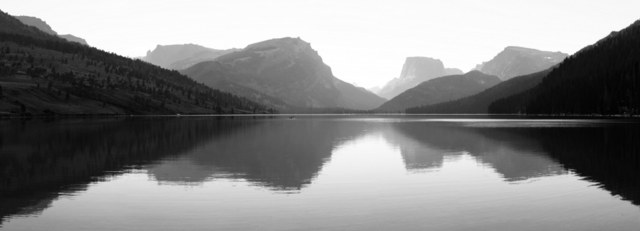
By Michael Gordon.
Short answer: AWESOME!
In the days of black and white film photography, filters (colored transparent glass) placed in front of the lens changed the way things looked. Haze is mostly blue, thus a red filter blocks haze and makes it seem to disappear.
Filter techniques can be used with digital color photographs. You can use any proportion of red, green, or blue to mimic the use of filters. In this example I am using the extremes of just the blue filter (blue channel of the image) which maximizes haze and makes distant things seem considerably more distant. It creates an exceptional sense of misty depth. The red channel makes landscapes sharp and high contrast with the sky almost black at times. It makes things look dramatic and up close.
Blue channel:

Red channel:

As my Nikon D200 is close to end-of-life, 95,000 photographs in 3.5 years, I have been looking for its replacement. Top choices were Nikon D300 or Nikon D700, both of which have been available for a year or more. the D300 uses my DX lenses, of which I have only two but the 18-200mm ED VR lens is a whopper and not one to easily be abandoned. However, it is also showing its age (VR lenses seem to be rather more delicate).
Faced with an opportunity for sports photography I chose to go with high sensitivity and a full frame sensor.
My first big surprise was that the RAW format has changed and suddenly my preferred RAW converter (Raw Shooter Essentials) no longer works. Now I am using Photoshop Essentials 6, and I had to download a new converter for it. Photoshop works well but it is not nearly as streamlined for handling large numbers of photos as compared to Raw Shooter Essentials.
Quality. Image quality is remarkably improved as compared to the Nikon D200 which itself has amazingly good picture quality. This quality manifests itself in fine gradations of color, saturation, low noise and freedom from clipping artifacts (color change when one channel clips). It has only a barely detectable increase in pixels, from 10 megapixels to 12, but the apparent sharpness is much improved. This is the first digital camera I have owned that I can really actually use an image at its native resolution, which is to say, it records about half again more detail than the Nikon D200.
Low Light Photography. This camera excels at night. Other cameras have more pixels, this one captures more photons. Imagine hand-held candid photography under city streetlights at ISO 3200. It works and it works well. It means you can use your inexpensive f3.5-f5.6 zoom lens in circumstances that otherwise would be impossible. All kinds of sports are obvious candidates, but so is night candid or human-interest photography. In the gallery is a photo of the Wasatch mountains at night. The mountains were not visible to my eye, but revealed themselves to the camera.
Noise. I have noticed a peculiar phenomenon; image noise seems a bit detached from ISO setting. To be sure, high ISO produces more noise, but low ISO does not entirely get rid of it either. I suspect this is an area where you can choose more sharpness (and its accompanying noise), or less noise and sharpness. Out of the box, the camera is amazingly sharp and can resolve a dot of light (a star, for instance), as a dot.